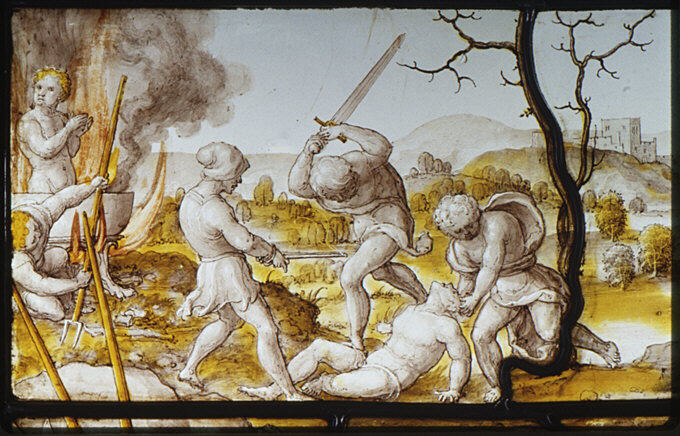Before the origins of Christianity the idea that Isaac was a willing volunteer to be sacrificed at his father Abraham’s hand was part of the smorgasbord of Jewish theological understandings. How did this notion arise? The answer to that question brings us to another Jewish idea that became the raw material from which Paul or other earliest Christian exegetes, including the authors of the gospels, drew inspiration for their teachings about Jesus Christ.
In the Genesis 22 narrative Isaac is a passive figure. The focus is entirely on Abraham’s faith and pious actions. Yet in the writings of Josephus, 4 Maccabees, and Pseudo-Philo’s Liber Antiquitatum Biblicarum (Biblical Antiquities) and the subsequent Palestinian Targum focus turns to Isaac as knowing what God requires of him and willingly, even enthusiastically, seeking to be sacrificed. Where did that idea come from?
In 4 Maccabees the blood of the (Maccabean) martyrs of the mid-second century BCE is said to atone for the sins of Israel, and by offering to die they imitate Isaac.

In the Palestinian Targum we finally see clues that explain how this interpretation of Isaac came about: Isaiah 53, the famous passage about the Suffering Servant, was linked to two just men who were prepared to die to save Israel.
There exist at least two midrashic passages in which the self-offering of a just man mentioned in the Torah is interpreted by quoting Isaiah liii. The first relates to Moses’ intercession for Israel after the worship of the golden calf. He implores God either to pardon his people, or else to blot his own name from the Book of Life (cf. Ex. xxxii. 32). According to Sotah 14a, Isaiah liii. 12 refers to this event:
He delivered his soul to death… and he took away the sins of many.
The second text, Sifre on Numbers xxv. 13, §131, applies the same verse of Isaiah to Phinehas, who was considered to have endangered his life by his zeal for God. His self-sacrifice and atonement are given a permanent value, and will continue to expiate Israel’s sins until the time of the Resurrection.
(Vermes, 203)
Vermes adds a third reference, one that applies Isaiah 53’s Servant directly to Isaac.
Jacob, called the young one, and Abraham, called the old one, are there, and Isaac, the Servant of the Lord (‘abda de YHWH) who was delivered from bonds by his Master. (Targum of Job 3)
Isaac is identified as the Servant of the Lord because of the midrashic interpretation of Isaac being “bound” by Abraham and then freed from those bonds.
It is precisely on account of his having been bound, i.e. because of his self-sacrifice, that Isaac appears to have been given the title, “Servant of the Lord”.
It would seem, therefore, safe to assume that the targumic haggadah on the Akedah resulted from the association of Genesis xxii and Isaiah liii. In addition, it is almost certain that this association was due to reflections on the significance of martyrdom. If the blood of martyrs is viewed by God as an expiatory sacrifice, a fortiori, the self-offering of Isaac atoned for the sins of his descendants.
(Vermes 203)
From that point, from the association of “binding” and “unbinding” in Genesis 22 with the Servant of the Lord in Isaiah 52:13-53:12, the figure of Isaac was delineated with other characteristics of that Isaiah 53 passage:
-
- Isaiah’s servant, like Isaac, is compared to a sacrificial lamb
- Isaiah’s servant, like Isaac, was ordained by God to be sacrificed
Isaiah’s Servant was cut off from the land of the living yet was promised to see his descendants. (Refer above to the links to archives where Levenson shows that some Jewish interpreters even believed Isaac’s blood had been spilled but that God restored him to life again.) Most significantly, the Servant is the just man who offers himself, in submitting to God’s will, for the sake of cleansing the sins of Israel.
In a recent post we saw how Paul was able to find “Christ crucified” “on a tree” in the Scriptures. Geza Vermes as early as 1961 elaborated on the above explanation for how Jewish interpreters were constructing concepts that were picked up and applied by Paul and other pioneering Christian authors.
(Another interesting point brought out in Vermes’ discussion is that the Jewish interpreters also viewed the daily sacrifices as serving the purpose of reminding God of the sacrifice of Isaac, the truly valuable sacrifice because it was that of a righteous man, not a mere animal. But that’s another discussion. )
– – – o 0 0 – – –
For the record — earliest writings presenting Isaac as a willing sacrifice: Continue reading “How Isaiah’s Suffering Servant and Isaac’s Sacrifice Together Prepared for Jesus Christ”
